
Original Link: https://www.anandtech.com/show/2039
Abit AB9 Pro: A sneak peek at Intel's new P965 chipset
by Gary Key on July 3, 2006 3:45 AM EST- Posted in
- Motherboards
As we mentioned in our Computex 2006 coverage, the rejuvenation of Abit was one of the more welcome surprises of the show. Abit was the top manufacturer of enthusiast level boards just a few short years ago and catered almost exclusively to the overclocking community. However, Abit found itself in serious trouble over the past couple of years as its product portfolio expanded to include video cards and a wide range of motherboards from the low end value segment to the upper end enthusiast sector. In essence, Abit tried to expand into areas where it did not have the manufacturing expertise or cost advantages to compete with the larger tier one manufacturers. As a result, Abit lost focus on its core competence, the enthusiast and overclocking market, and allowed DFI to become the number one brand name in an area where users are highly passionate about their products.
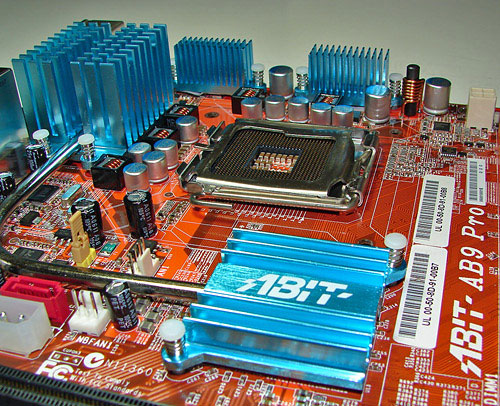
Toward the end of 2005, Abit was close to ceasing business operations as their product lines did not offer any real price, performance, or product differentiation from others except for their µGuru technology. Fortunately, Abit entered into a long-term partnership with USI this past January that ensures their financial health for the future and a change in the company name. Universal Abit is the successor to the Abit motherboard brand and has partnered with USI for their manufacturing and engineering expertise.
The Abit name will remain as the main identity for products but expect to hear more from Universal Abit as the company transitions itself from strictly IT manufacturing to leading technology design and brand management. This strategic partnership also signals a return of Abit to their roots as a company driven to provide the computer enthusiast and extreme overclocker with the highest performance solutions available. While we have not received their new Max or Fatal1ty product lines for review yet, Abit was generous enough to send us their mainstream Intel performance board -- the AB9 Pro -- based upon the new Intel P965 Express chipset.
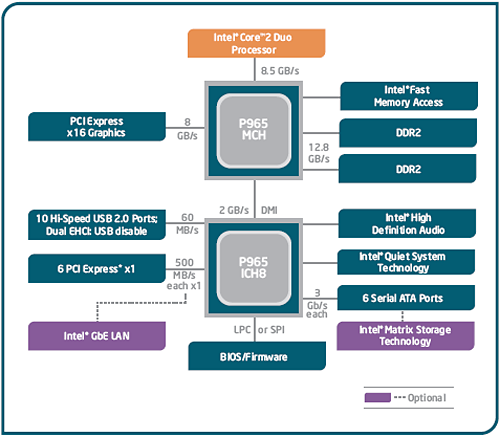
Intel released the P965 Express MCH and ICH8/R chipsets during Computex 2006. While we will take a closer look at this new mainstream chipset in future articles, the highlights of the P965 MCH include Intel's new Fast Memory Access technology, 1066MHz front side bus support, 800MHz DDR-2 memory support, and full support for the new Core 2 Duo processor lineup. The integrated graphics versions, G965 and Q965, will ship with the new GMA X3000 graphics engine for the ViiV and Corporate markets respectively. The new ICH8/R chipsets offer ten USB 2.0 ports, up to six 3Gb/s SATA ports, Intel's new Quiet System Technology, and the removal of Parallel ATA support.
While one could argue that the removal of PATA support is a needed step forward in technology, we firmly believe that Intel should have waited until the next generation ICH for this change. The Optical Drive market is still about 98% PATA based and does not seem to be changing anytime soon. While this development might spur the optical drive suppliers into offering additional SATA drives in the near future, it does not address the requirements of the current PATA installed base. This most likely means there will be additional costs and complexity on the motherboards using ICH8 as the manufacturers will have to add an additional chipset for PATA support. (Manufacturers could simply choose not have any PATA ports, but at present we feel such a motherboard would be doomed to fail.)
Abit will be one of the first manufacturers to market with a P965 based board and we will take a quick but strictly preview look at the AB9 Pro today. While this motherboard is a production release unit, the BIOS is still undergoing almost daily revisions at this time. We will state at this point that our current BIOS release offers significant functionality, very good base performance, but will not yet allow us to change memory speeds or timings. Please keep this in mind as you compare the performance results against our Asus 975X based board. We will give this board a more in depth review during our forthcoming Intel Core 2 Duo motherboard roundup. Let's see what this board has to offer at this time.
Board Layout and Features
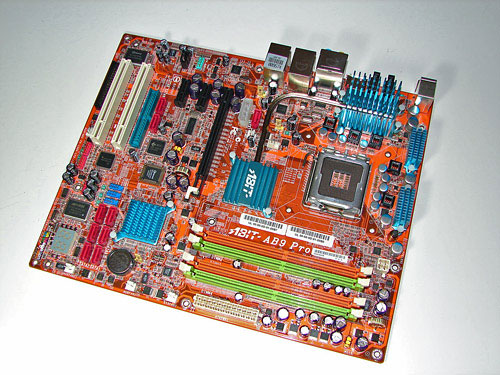 |
| Click to enlarge |
Abit designed a board that has one of the more interesting layouts we have seen in our labs in a long time. While the board was very easy to install in our mid-size ATX case, we did have some issues with utilizing our optical drive in the top bay due to the location of the JMicron powered IDE port that is located in between the number two PCI Express X1 slot and the number one PCI slot. The Abit board features an excellent voltage regulator power design with high quality capacitors located in each major component section of the board that yielded superb stability with our early BIOS revisions. Our board was able to POST our 805D at 4660MHz but we could not enter Windows due to the inability to change memory timings with the current BIOS. We certainly foresee this board being excellent at overclocking if the BIOS matures properly.
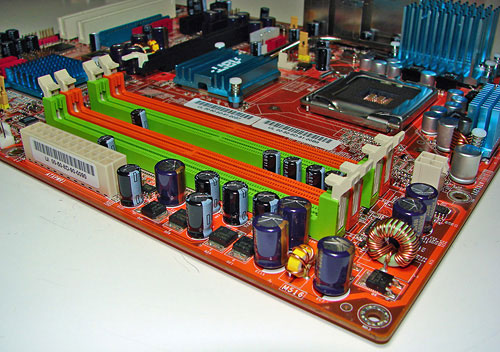 |
| Click to enlarge |
The DIMM module slots' color coordination is correct for dual channel setup based upon the premise of utilizing different colors for each memory bank. The memory modules are easy to install with a full size video card placed in the first PCI Express X16 slot. The 24-pin ATX power connector is located along the edge of the board along with a series of capacitors for the memory modules. Abit places the four-pin 12v auxiliary power connector at the top of the first memory module but completely out of the way of aftermarket cooling solutions.
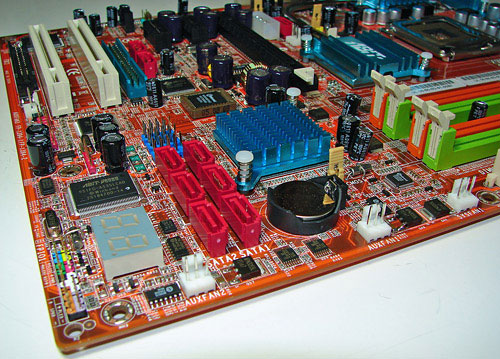
The six Intel ICH8R SATA ports are color coded red and are located to the left of the ICH8R Southbridge and battery. The SATA ports feature the newer clamp and latch design. We found the positioning of the SATA ports to be excellent when utilizing either the PCI-E X1 or PCI 2.3 slots. The ICH8R is passively cooled and remained cool to the touch throughout testing.
The first three of five auxiliary fan connectors are located at the bottom edge of the board. The clear CMOS jumper is color coded yellow and is located in between the battery and ICH8R chipset. The CP80P POST port debug LED, chassis panel, µGuru chipset, and red 1394a connectors are located along the left edge of the board. The blue USB 2.0 connectors are located above the SATA ports.

The board comes with one physical PCI Express X16 connector, two PCI Express X1 connectors, and two PCI 2.3 connectors. The layout of this design offers a very good balance of expansion slots for a mainstream board while providing excellent clearance space for graphics card utilization. However, the layout in this area is very unusual if not a bit chaotic. Our main issue is the location of the floppy drive connector at the bottom of the board along with the JMicron JMB363 IDE and SATA ports being sandwiched in between the PCI-E and PCI slots in the middle of the board.
The four-pin molex power connector that will be required for future GPU products and the Silicon Image 3132 SATA port is located above the PCI-E X16 slot. The P965 chipset will not officially support CrossFire or SLI operation so the lack of a secondary PCI-E X16 slot means this board could have been arranged differently. However, Abit informed us that some of the unusual port locations were predicated upon ensuring proper power delivery, stability, and trace layouts based upon the capacitor locations. That may be true, but we think they would do better to add more capacitors and do whatever else is necessary to accommodate a more ideal layout, as frankly the current layout really isn't what we'd like to see.
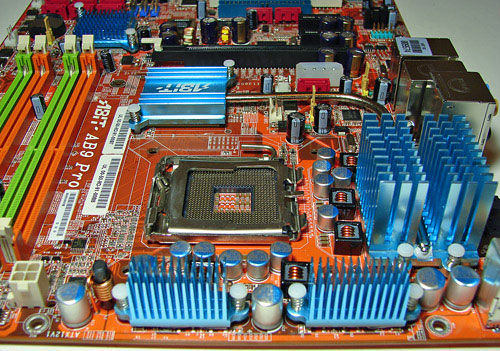 |
| Click to enlarge |
Returning to the CPU socket area, we find an ample amount of room for alternative cooling solutions. We utilized the stock heatsink/fan in our normal testing but also verified a couple of larger Socket-775 cooling solutions would fit in this area during our overclocking tests.
The Intel P965 MCH chipset is passively cooled with a low rise heatsink unit that did not interfere with any installed peripherals. This heatsink is part of the Abit Silent OTES technology that includes a heatpipe system and additional passive cooling for the VRM components. This system kept the MCH cool enough that additional chipset voltage was not a factor in our overclocking tests.
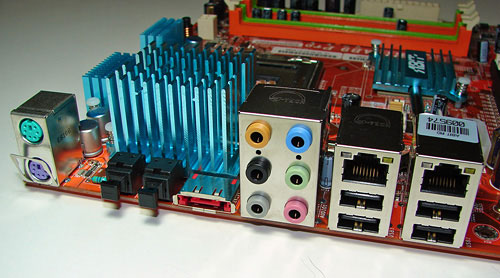
The rear panel contains the standard PS/2 mouse and keyboard ports, LAN ports, and 4 USB ports. The LAN (RJ-45) ports have two LED indicators representing Activity and Speed of the connection through the Realtek RTL8111B Gigabit PCI-E chipset. The audio panel consists of 6 ports that can be configured for 2, 4, 6, and 8-channel audio connections for the Realtek ALC 882D HD codec. The panel includes two S/PDIF (optical in/optical out) ports, and an external SATA 3Gb/s port via the Silicon Image 3132 chipset.
Test Systems
All three boards we're including in the benchmarks support current socket 775 Intel processors, and the Abit AB9 Pro and NVIDIA 590 SLI Intel Edition will fully support the Intel Core 2 Duo processors upon release. We did our benchmarking with the Pentium D 805 processor but will follow up shortly with the Pentium 950D and 955XE benchmarks once we receive our production release BIOS. The Abit AB9 Pro fully supported our E6300, E6600, and X6800 Core 2 Duo processors, but we cannot provide results at this time due to NDA restrictions.
| Test Systems | |
| Processor: | Intel Pentium D 805 |
| RAM: | 2 x 1GB Corsair TWIN2X2048-6400C3 |
| RAM Settings: | 5-5-5-12 533MHZ, 2.100V - Abit 3-2-2-8 533MHZ, 2.250V - Asus/NVIDIA |
| OS Hard Drive: | 1 x WD Raptor 74GB 7200 RPM SATA (8MB Buffer) |
| System Platform Drivers: | NVIDIA Platform Driver - 9.35 Intel Platform Driver - 8.0.1.1002 |
| Video Card: | 1 x EVGA 7900GTX (PCI Express) for all tests |
| Video Drivers: | NVIDIA nForce 91.31 WHQL |
| Optical Drive: | BenQ DW1640 |
| Cooling: | Retail Intel HSF |
| Power Supply: | OCZ GamexStream 700W |
| Case: | Gigabyte 3D Aurora |
| Operating System: | Windows XP Professional SP2 |
| Motherboards: | Abit AB9 Pro NVIDIA nForce 590 SLI Intel Edition Asus P5WD2-E Premium |
A 2GB memory configuration is now standard in the AT test bed as most enthusiasts are currently purchasing this amount of memory. We chose memory from Corsair that would offer a wide range of memory settings during our stock and overclocked test runs. Our memory timings are set based upon determining the best memory bandwidth via MemTest 86 and our test application results for the Asus and NVIDIA boards. Our current beta level Abit BIOS locked the memory timings at 5-5-5-12 so we also tested the Asus board at this setting in order to provide a fair comparison.
All other components in our test configurations are exactly the same with the boards being set up in their default configurations. Our video tests are run at 1280x1024 resolution for this article at standard settings. We will not report on 1600x1200 4xAA/8xAF single and SLI until we have a production ready BIOS to review. This holds true for the balance of our Networking, Storage System, and Audio benchmarks.
Synthetic Graphics Performance
The 3DMark series of benchmarks developed and provided by Futuremark are among the most widely used tools for benchmark reporting and comparisons. Although the benchmarks are very useful for providing apple to apple comparisons across a broad array of GPU and CPU configurations, they are not a substitute for actual application and gaming benchmarks. In this sense we consider the 3DMark benchmarks to be purely synthetic in nature but still valuable for providing consistent measurements of performance.
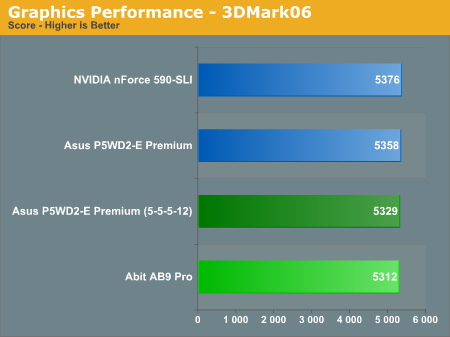
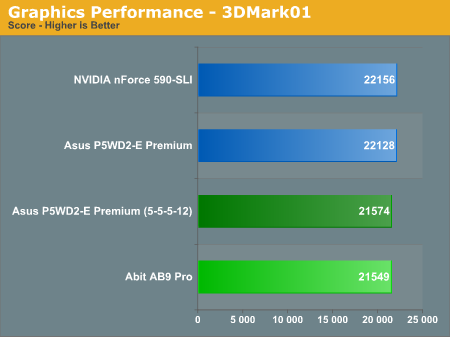
In our first tests, each platform score is so close that there is no winner here. In the memory and CPU sensitive 3DMark01 benchmark we see the Asus and Abit boards scoring extremely close at the same memory timings. Although we have not reported memory benchmarks scores in this article, the Abit and Asus boards performed almost identically at the same settings indicating the P965 Express chipset will have excellent memory performance.
General System Performance
The PCMark05 benchmark developed and provided by Futuremark was designed for determining overall system performance for the typical home computing user. This tool provides both system and component level benchmarking results utilizing subsets of real world applications or programs. This benchmark is useful for providing comparative results across a broad array of graphics cards, CPUs, hard disks, and memory configurations and it also includes some multithreading results. In this sense we consider the PCMark benchmark to be both synthetic and real world in nature while providing consistency in our benchmark results.
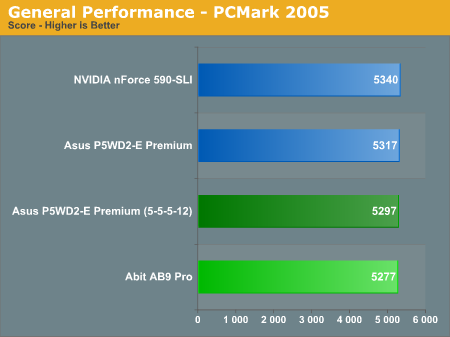
The margins are extremely close in the PCMark05 results but the NVIDIA platform continues to show a very slight advantage over the Intel platform. While looking at the individual test results, we noticed the Abit board matched the other boards in the graphics tests and finished slightly behind in the multitasking tests due to the memory settings. We also noticed the NVIDIA nForce 500 Intel Edition board had 19% better performance than either Intel board in the XP Hard Disk Drive Startup test, with the ICH8R Abit performing 4% better than the ICH7R on the Asus.
Media Encoding Performance
For media encoding, our first test is quite easy - we take our original Office Space DVD and use AnyDVD Ripper to copy the full DVD to the hard drive without compression, thus providing an almost exact duplicate of the DVD. We then fire up Nero Recode 2, select our Office Space copy on the hard drive, and perform a shrink operation to allow the entire movie along with extras to fit on a single 4.5GB DVD disc. We left all options on their defaults except we checked off the advanced analysis option. The scores reported include the full encoding process and is represented in minutes, with lower numbers indicating better performance.
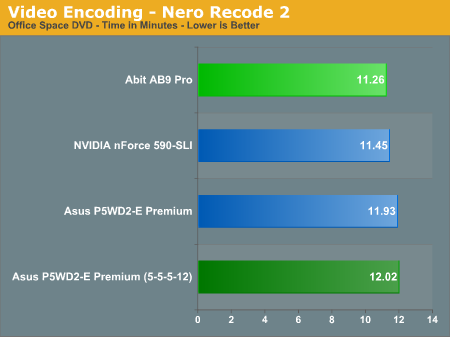
The results left us amazed with the Abit P965 board scoring 7% better than the Asus i975X board at the same memory settings while still bettering our NVIDIA board that placed first in our previous tests. We ran the benchmark several times and verified our settings before accepting the test results. It will be interesting to see if this pattern continues with other P965 based boards.
Audio Encoding Performance
While the media encoding prowess of the Abit AB9 Pro was superb in our initial media encoding testing, we wanted to see how it fared on the audio side. Our audio test suite consists of Exact Audio Copy v095.b4, LAME 3.98a3, LAME MT3.97a-MS Compiler, and Nero Digital Audio. We utilize the INXS Greatest Hits CD that contains 16 tracks totaling 606MB of one time '80s hits.
Our first test consists of utilizing Exact Audio Copy as the front end for our differing versions of LAME. We set up EAC for variable bit rate encoding, burst mode for extraction, use external program for compression, and to start the external compressor upon extraction. (EAC will read the next track while LAME is working on the previous track, thus removing a potential bottleneck with the optical drive.)
Our two versions of LAME consist of the recently released 3.98a3 and LAME MT 3.97a, which is a multi-threaded version of the LAME MP3 encoder. LAME MT was originally designed as a demonstration to show the advantages of multi-threading on the Pentium 4 with Hyper-Threading enabled. Instead of running multiple parallel threads, LAME MT generates the encoder's psycho-acoustic analysis function in a separate thread from the rest of the encoder using a simple linear pipeline. The results are presented in minutes for the encoding process, with lower numbers being better.
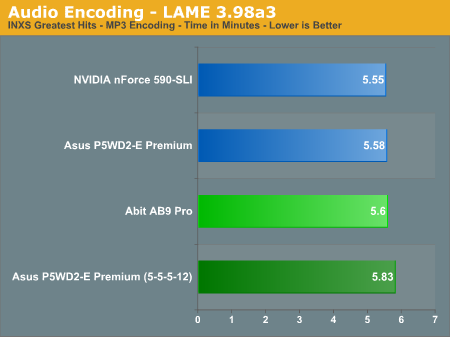
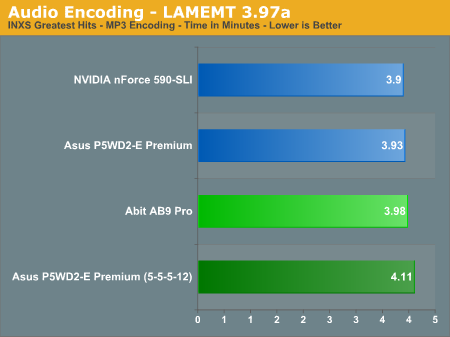
As in the media encoding section, the more intensive CPU and storage system tests seem to favor the P965 over the i975X when running at the same memory timings and are near that of the two results at lower memory timings. Even at this early stage we see some benefits of the reworked/enhanced memory controller on the P965. When utilizing LAME MT we see upwards of a 35% improvement in encoding times. This once again shows the advantages of programs written to take advantage of multiple-core processors.
Audio Encoding Performance
Our last audio test utilizes Nero Digital Audio to extract all 16 tracks and convert them into an MP4 format. We changed the default quality settings to transcoder-ultra, variable bit rate, encoder quality to high, and the AAC profile to LC in order to properly stress our systems.
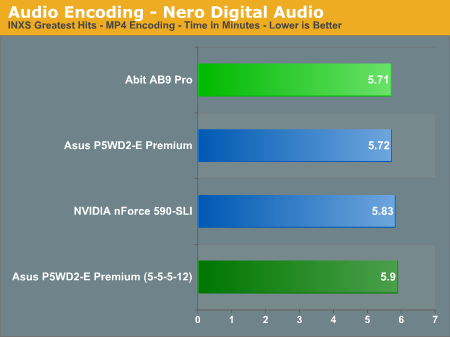
These results have left us impressed with the performance of the Abit AB9 Pro and the Intel P965 chipset considering our beta BIOS on this board. The Abit board is about 3% faster in this benchmark over the Asus board at the same memory settings and finishes first overall. It is obvious that the CPU/memory subsystem performance of the P965 is excellent considering the high memory latencies.
File Compression Performance
In order to save space on our hard drives and ensure we had another CPU crunching utility, we will be reporting our file compression results with the latest beta version of WinRAR that fully supports multi-threaded operations and should be of particular interest for those users with dual core or multi-processor systems. Our series of file compression tests utilizes WinRAR 3.60b5 to compress our test folder that contains 444 files, ten subfolders, and 602MB worth of data. All default settings are utilized in WinRAR along with our hard drive being defragmented before each test.
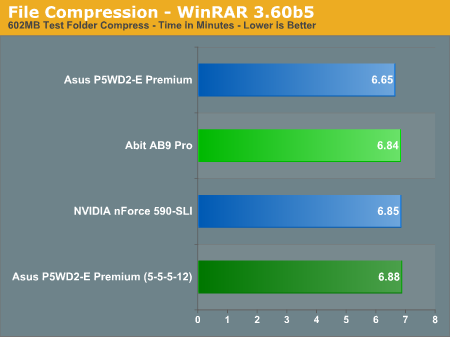
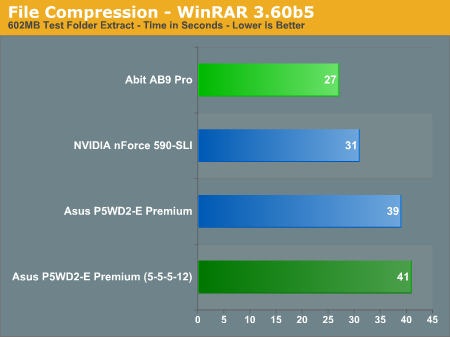
The results speak for themselves with the Intel P965 based system outperforming our previous best scores with the NVIDIA chipset by 14% in the decompression tasks and by 51% over the i975X system at the same settings. We have contacted Asus about the results as we believe this to be a potential BIOS or timing issue and not a true reflection of the i975X chipset based on other results. However, we see the i975X system finishing in front in the grueling compression test (3% faster) over the NVIDIA board, and the Asus board barely trailed the Abit board at equalized memory settings. Once again, we ran the test several times with the same results. The decompression tests are generally more limited by storage system performance whereas the compression tests stress the memory subsystem more in our benchmarks. It will be interesting to see how the Abit AB9 Pro performs once we have a BIOS that allows changes to the memory settings.
Gaming Performance
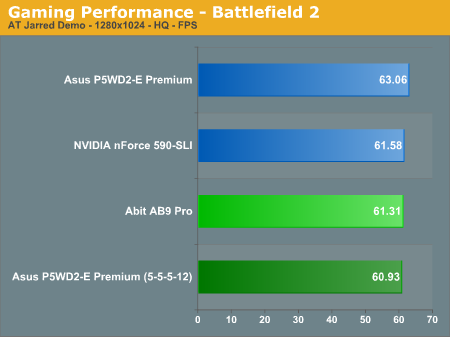
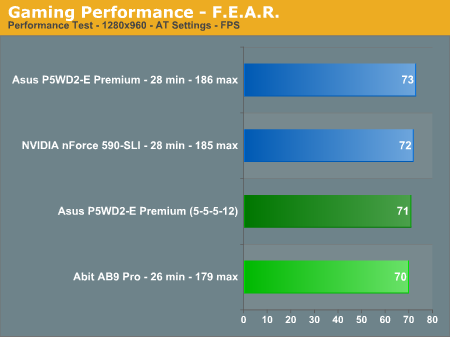
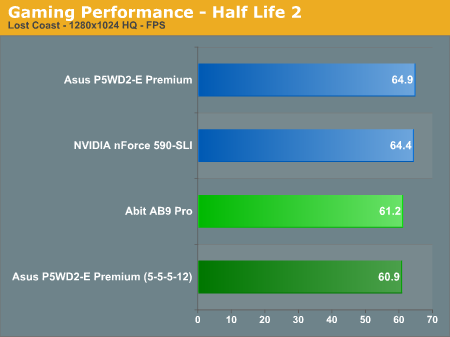
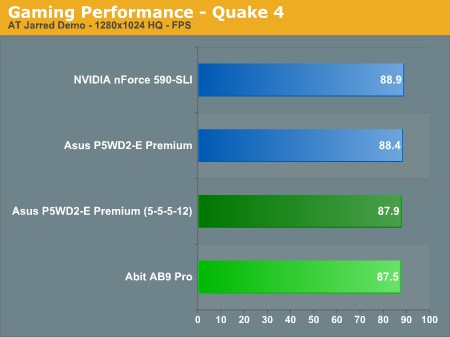
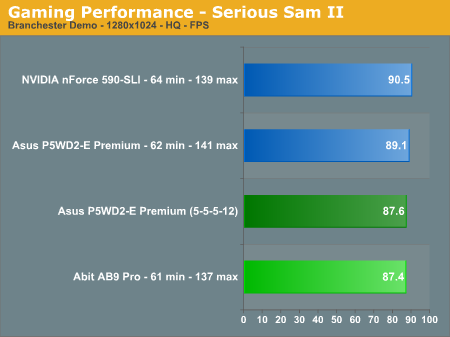
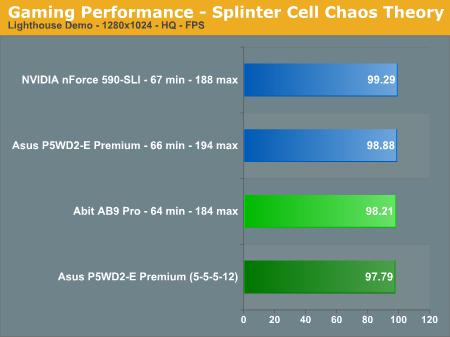
The overall gaming performance of all three platforms with the Pentium D 805 is actually decent considering the processor speed, memory bandwidth, and heavy reliance upon the video card to generate these scores. As in the synthetic tests, the higher memory settings on the Abit board have a detrimental effect on our gaming scores. The Abit and Asus boards at the same memory settings are basically equal in these benchmarks which shows that memory performance can make a difference (however slight) in your gaming experience.
Final Words
Our preview of the Abit AB9 Pro shows a board with a high level of performance potential provided the production BIOS allows tweaking of the memory settings. Abit ensures us we will have a BIOS with this capability shortly and we look forward to testing the board again with our Pentium D processors and providing Core 2 Duo results in the near future. While we did not notice any other issues with the Abit system during a rigorous test schedule, we have to state once again that the overall layout is unusual if not chaotic. While this may appeal to some, we found the location of the IDE and floppy port connectors to be very difficult to work with in our test case. These port locations required the use of long cables and the partial blockage of airflow over the CPU and memory locations, certainly not what you want with a Pentium D processor.
Our other issue is the lack of a secondary PCI-E X16 physical slot that could provide PCI-E X4 capability for an additional graphics card or other PCI-E peripherals. We feel like this would have been a better option than providing two PCI-E X1 slots -- in fact, we would like to see all motherboard manufacturers begin to only use X16 physical connectors for all PCI-E slots; there ought to be at least some cost benefit in only purchasing one type of plastic connector, though of course we're simplifying things a bit. We do commend Abit on providing Dolby Digital support via the Realtek ALC882D, dual Gigabit Ethernet controllers that use the PCI-E interface, an e-SATA port, Silent OTES system, and their impressive µGuru technology for overclocking and full system monitoring/control capabilities. We will provide a full feature list and results for networking, storage, and audio in our full review of this interesting if not funky board once our Core 2 Duo NDA expires.
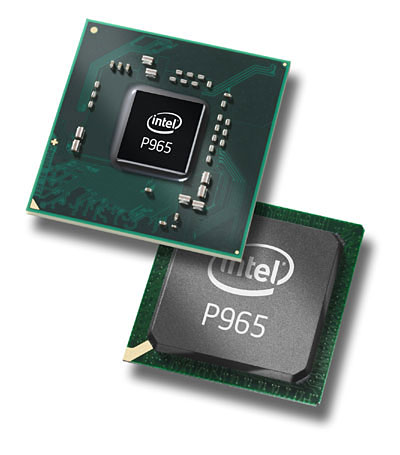
This was our first experience with the Intel P965 Express chipset and even with the lack of memory settings and limited overclocking capabilities due to our early BIOS, we have to say this chipset was impressive from both a performance and stability viewpoint. This has generally been the trademark of Intel chipsets and the P965 is no different. However, the lack of official dual X8 GPU capability at this time means you will have to look elsewhere for CrossFire or SLI support. This really is a huge oversight or mistake by Intel as this chipset certainly offers very good performance across the board. Our other issue is the lack of native PATA support on the ICH8R; this is not acceptable considering the almost absolute reliance on the PATA interface for optical drives at this time. Look for additional Core 2 Duo supporting i975X, P965, and NVIDIA 590/570 SLI Intel Edition motherboard previews in the near future, along with a surprise or two from VIA and SIS.







